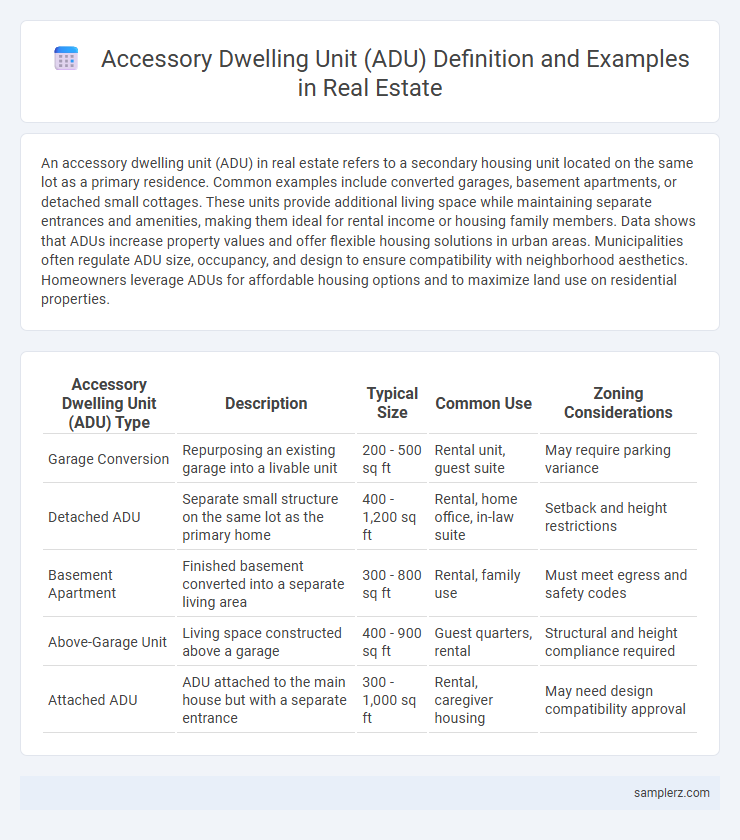An accessory dwelling unit (ADU) in real estate refers to a secondary housing unit located on the same lot as a primary residence. Common examples include converted garages, basement apartments, or detached small cottages. These units provide additional living space while maintaining separate entrances and amenities, making them ideal for rental income or housing family members. Data shows that ADUs increase property values and offer flexible housing solutions in urban areas. Municipalities often regulate ADU size, occupancy, and design to ensure compatibility with neighborhood aesthetics. Homeowners leverage ADUs for affordable housing options and to maximize land use on residential properties.
Table of Comparison
| Accessory Dwelling Unit (ADU) Type | Description | Typical Size | Common Use | Zoning Considerations |
|---|---|---|---|---|
| Garage Conversion | Repurposing an existing garage into a livable unit | 200 - 500 sq ft | Rental unit, guest suite | May require parking variance |
| Detached ADU | Separate small structure on the same lot as the primary home | 400 - 1,200 sq ft | Rental, home office, in-law suite | Setback and height restrictions |
| Basement Apartment | Finished basement converted into a separate living area | 300 - 800 sq ft | Rental, family use | Must meet egress and safety codes |
| Above-Garage Unit | Living space constructed above a garage | 400 - 900 sq ft | Guest quarters, rental | Structural and height compliance required |
| Attached ADU | ADU attached to the main house but with a separate entrance | 300 - 1,000 sq ft | Rental, caregiver housing | May need design compatibility approval |
What Is an Accessory Dwelling Unit (ADU)?
An Accessory Dwelling Unit (ADU) is a secondary housing structure on a single-family residential lot, often referred to as a granny flat, in-law unit, or backyard cottage. Common ADU examples include converted garages, basement apartments, or detached guest houses that provide independent living spaces with kitchens, bathrooms, and bedrooms. ADUs enhance property value, offer affordable rental income potential, and increase housing density in urban and suburban neighborhoods.
Popular Types of Accessory Dwelling Units in Real Estate
Popular types of accessory dwelling units (ADUs) in real estate include detached guest houses, basement apartments, and garage conversions, each offering flexible housing options that maximize property value. Detached guest houses provide privacy and independence, while basement apartments typically utilize existing space for rental income. Garage conversions transform underused areas into livable units, enhancing urban housing density and affordability.
Garage Conversion ADUs: A Space-Saving Solution
Garage conversion accessory dwelling units (ADUs) transform underutilized garage spaces into fully functional living areas, maximizing property value and increasing rental income potential. These space-saving solutions offer cost-effective housing options without the need for extensive land expansion or new construction. Implementing garage conversion ADUs supports sustainable urban densification while preserving existing neighborhood aesthetics.
Basement Apartments as Accessory Dwelling Units
Basement apartments serve as a common example of accessory dwelling units (ADUs) in real estate, providing additional living space within a single-family home property. These units typically include separate entrances, kitchens, and bathrooms, offering independent housing options that increase property value and rental income potential. Local zoning laws and building codes regulate basement ADUs to ensure safety, habitability, and compliance with community standards.
Detached ADUs: Standalone Backyard Cottages
Detached ADUs, also known as standalone backyard cottages, provide homeowners with independent living spaces separate from the primary residence, often featuring a bedroom, bathroom, and kitchenette. These structures increase property value and offer flexible options for rental income, multigenerational living, or guest accommodations. Local zoning laws and building codes typically regulate the size and placement of detached ADUs to ensure neighborhood compatibility and safety.
Attached ADUs: Expanding Existing Homes
Attached Accessory Dwelling Units (ADUs) are built as an extension to the main house, providing additional living space while maintaining structural integration with the existing property. Common examples include converted garages, finished basements, or new room additions that serve as separate living quarters with private entrances. These attached ADUs increase property value and rental income potential while preserving neighborhood aesthetics and zoning compliance.
Above-Garage Accessory Dwelling Unit Examples
Above-garage accessory dwelling units (ADUs) maximize unused space by converting the area above a garage into a compact living space, typically ranging from 400 to 800 square feet. These ADUs often include essential amenities such as a small kitchen, bathroom, and bedroom, making them ideal for guest housing or rental income. Cities like Los Angeles and Portland have embraced above-garage ADUs to increase urban density while preserving neighborhood aesthetics.
Prefabricated Accessory Dwelling Units for Quick Installation
Prefabricated Accessory Dwelling Units (ADUs) offer efficient solutions for maximizing property value and providing additional rental income within residential real estate. These modular structures are constructed off-site and delivered for rapid assembly, significantly reducing installation time compared to traditional building methods. Homeowners benefit from cost-effective, high-quality housing options that comply with local zoning and building codes, facilitating faster occupancy and enhanced property utilization.
Legal and Zoning Considerations for ADUs
Accessory dwelling units (ADUs) are subject to specific legal and zoning regulations that vary significantly by jurisdiction, including restrictions on size, height, and setback requirements to ensure compliance with local land use policies. Property owners must obtain proper permits and adhere to building codes that address safety, occupancy limits, and utility connections to avoid legal penalties. Understanding municipal zoning ordinances and state laws, such as California's ADU statute, is crucial for successfully adding an ADU to a residential property.
Investment Benefits of Accessory Dwelling Units in Real Estate
Accessory Dwelling Units (ADUs) offer significant investment benefits in real estate by generating steady rental income and increasing property value. These units provide homeowners with flexible living arrangements, making properties more attractive to buyers and tenants seeking affordable housing options. By maximizing land use without additional property acquisition costs, ADUs enhance cash flow while diversifying investment portfolios.

example of accessory dwelling unit in real estate Infographic
 samplerz.com
samplerz.com